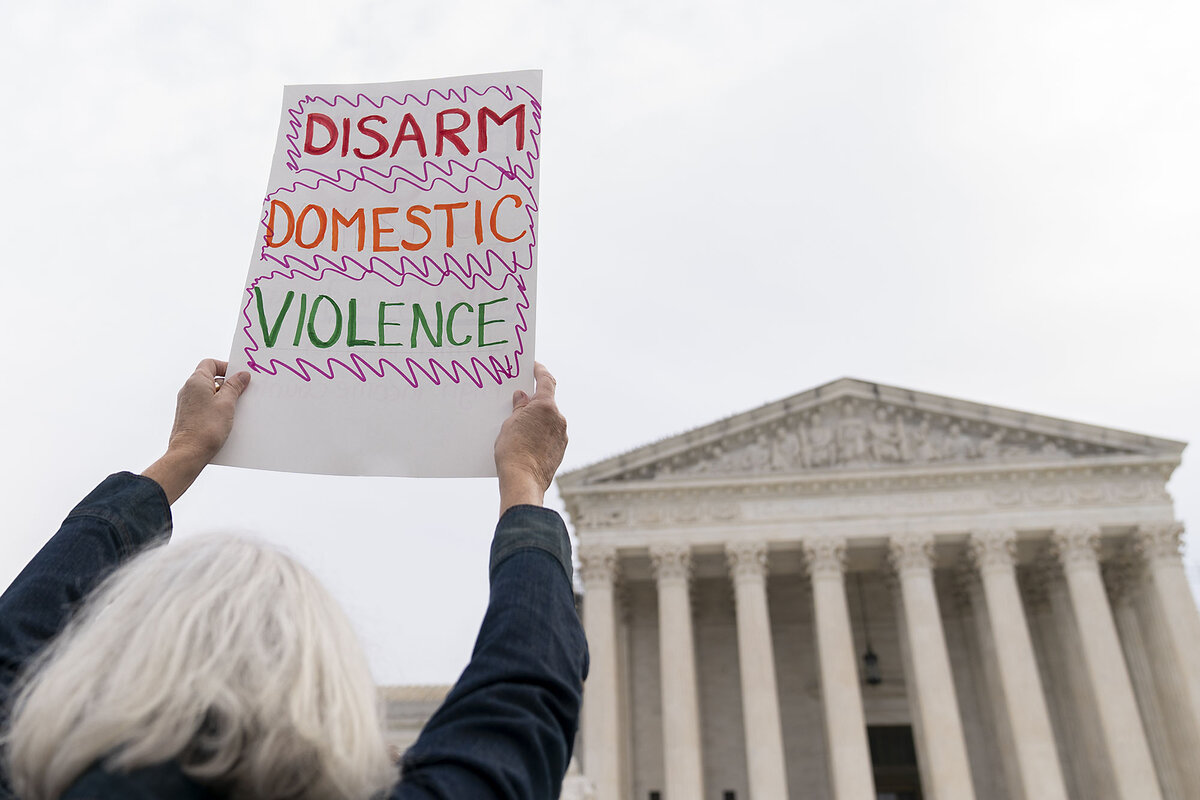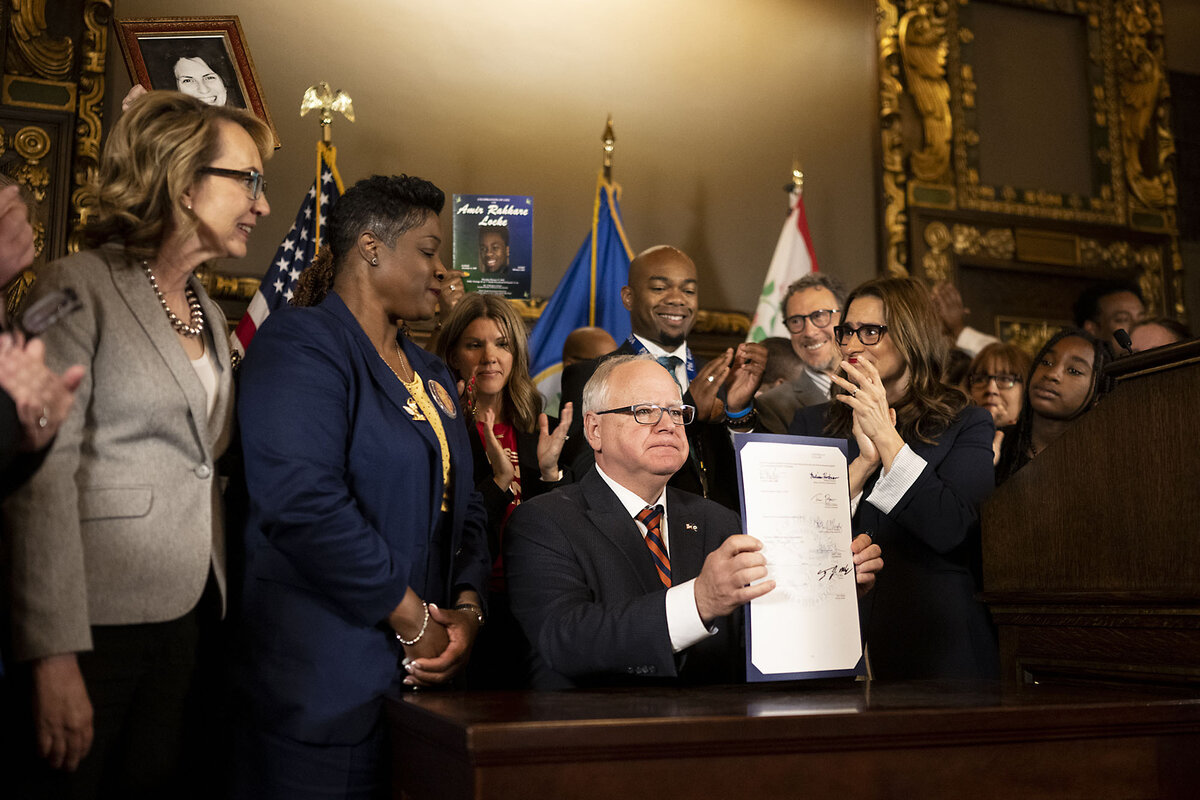After years of expanding gun rights, Supreme Court sets a limit on Second Amendment
Loading...
In a near-unanimous ruling Friday, the U.S. Supreme Court set the outer bounds on the constitutional right to bear firearms that it has been expanding for almost two decades.
As in other recent gun rights cases, the decision grappled with the Second Amendment and its implications for modern public safety. At issue, in particular, is the safety of people who are or were in abusive relationships.
The case challenged a federal law prohibiting an individual subject to a domestic violence restraining order from possessing a firearm. Also known as red flag laws, these have been passed in 21 states and the District of Columbia. The plaintiff, Zackey Rahimi, claimed that the law is unconstitutional, citing a Supreme Court ruling two years ago that gun laws must be consistent with America’s history and tradition of firearm regulation.
Why We Wrote This
The 21st century has seen a steady expansion of U.S. gun rights. On Friday, the Supreme Court walked back a controversial ruling from two years ago that had confounded lower courts.
In an 8-1 decision – albeit one in which six justices wrote four separate opinions – the Supreme Court disagreed.
Recent precedents “were not meant to suggest a law trapped in amber,” wrote Chief Justice John Roberts in the .
“The reach of the Second Amendment is not limited only to those arms that were in existence at the Founding,” he added. “By that same logic, the Second Amendment permits more than just regulations identical to those existing in 1791.”
While even some gun rights supporters had misgivings about the case, the ruling surprised court watchers who have witnessed the court steadily expand gun rights. Despite the ruling Friday, more challenges over the scope of one of the country’s most polarizing constitutional protections are in the pipeline.
The 21st century has so far seen the expansion of gun rights. In District of Columbia v. Heller in 2008, the court held for the first time that the Second Amendment protected the right to keep a gun in the home. In New York State Rifle Association v. Bruen in 2022 – the case cited by Mr. Rahimi – the court held that the Constitution protects the right to carry a gun in public, which also created the “history and tradition” test. Both decisions broke along the court’s ideological lines. And just last week, Justice Clarence Thomas wrote an opinion that struck down a ban on bump stocks, or semiautomatic weapon enhancers, adopted during the Trump administration.
The 2022 Bruen decision offered little guidance to lower-court judges on how to apply the history-and-tradition test, and the past two years have been replete divergent court rulings in constitutional challenges to gun regulations. With its ruling Friday, the Supreme Court has begun to reconcile the new judicial focus on early U.S. history with the realities of modern-day America.
Friday’s ruling was a welcome clarification of Bruen, Justice Sonia Sotomayor wrote in a concurrence joined by Justice Elena Kagan. But the justices “remain troubled by Bruen’s myopic focus on history and tradition, which fails to give full consideration to the real and present stakes of the problem facing our society today.”
A ruling that is “transferable to the present day”
Mr. Rahimi is not the champion most gun rights supporters would have chosen for the next big Second Amendment case.
Indeed, Chief Justice Roberts began the 103 pages of opinions with a graphic detailing of his criminal history, including violation of a restraining order against his girlfriend, a separate aggravated assault charge, and alleged involvement in five other shootings across the Dallas-Fort Worth area. Those facts help explain why the decision was nearly unanimous, but also why it is relatively narrow.
“It was about a specific person, which is in the heartland of what’s permissible under historical principles,” says Andrew Willinger, executive director of the Center for Firearms Law at Duke University in North Carolina.
The analysis in Friday’s decision boiled down to the question of whether a gun regulation needs to simply be analogous to a founding-era regulation, or whether the modern regulation needs a clear historical “twin.” Eight justices agreed that the former is satisfactory.
In a solo dissent, Justice Thomas – who wrote the Bruen decision – disagreed. Because neither the government nor the majority “identifies a single historical regulation with a comparable burden and justification as” the federal law, he wrote, “I would conclude that the statute is inconsistent with the Second Amendment.”
In a separate concurrence, Justices Sotomayor and Kagan underscored why they supported Chief Justice Roberts’ interpretation. The majority opinion “permits a historical inquiry calibrated to reveal something useful and transferable to the present day,” they wrote.
The dissent, meanwhile, “would make the historical inquiry so exacting as to be useless,” they added.
The debate between the justices – visible throughout the lengthy opinion – is enlightening, legal experts say. That’s both for lower-court takes in applying Bruen’s history-and-tradition test and for the future of the high court’s Second Amendment jurisprudence.
The court “loosened the Bruen analysis to build in more wiggle room. That will be a welcome bit of guidance for litigants,” says Eric Ruben, a professor at Southern Methodist University Dedman School of Law and a fellow at the Brennan Center for Justice.
The fact that eight justices signed on to the majority opinion, he adds, suggests “that in so many ways, the other justices are wresting the Second Amendment from Justice Thomas.”
What does this mean for survivors of domestic abuse?
In addition to clarifying the Bruen test, the case also has profound implications for Americans in domestic violence situations.
The presence of a firearm makes it five times more likely that a person will be killed by their abuser, according to a . One across 49 states found that court-ordered seizures of firearms reduced intimate partner homicides by 13%.
Nor are the threats limited to intimate partners, says Jennifer Becker, a former New York City prosecutor who specialized in domestic violence cases.
Survivors report that abusive partners threaten suicide or to hurt other people in the community. There is a between . Federal law, in essence, says, “Let’s just remove the firearms that elevate the risk so much,” says Ms. Becker, now the director of the National Center on Gun Violence in Relationships, part of the Battered Women’s Justice Project in St. Paul, Minnesota.
“We should all as a community have an interest in removing this risk of fatality. We should all care about laws that acknowledge that domestic violence isn’t a private matter,” she adds.
Gun safety advocates are not alone in wanting this. Nearly 8 in 10 gun owners support prohibiting gun possession by people subject to a domestic violence restraining order, according to a by Tufts University funded by 97Percent, an advocacy group that promotes responsible gun ownership and enhances public safety.
Grass Roots North Carolina was one of several gun groups that signed amicus briefs supporting Mr. Rahimi – but not without a lot of internal debate about the nature of the case, the defendant’s character, and the implications if Mr. Rahimi succeeded.
“Bad cases make bad laws,” says Paul Valone, president of Grass Roots North Carolina.
But domestic violence protection orders are “a vulnerable area for gun rights,” says Mr. Valone, an airline pilot. “It is one of the most routine methods by which gun owners are deprived of their weapons – which can include collections worth hundreds of thousands of dollars.”
Gun groups have a broader concern that Second Amendment rights are more fungible than others. The ruling Friday suggests to Mr. Valone that courts may again treat the Second Amendment as, quoting Justice Thomas, “a second-class right.”
The decision was “exactly what I expected,” Mr. Valone adds. “Thanks to the fact that they used the flawed defendant to bring the case to the Supreme Court, people who’ve committed no crimes will now be deprived of their civil rights.”
But the narrowness of the majority opinion, and the presence of four separate concurring opinions, suggest that the future of Second Amendment jurisprudence is entering a murky new era.
A challenge to an Illinois law regulating assault weapons and high-capacity magazines is now pending before the Supreme Court. Challenges to laws disarming drug users and nonviolent offenders are also likely to reach the justices. In all these cases, they will have to further clarify the Bruen test. It’s far from clear how the court will rule.
In separate, solo concurrences, Justices Neil Gorsuch and Brett Kavanaugh wrote long defenses of the high court’s originalist, history-focused approach in Bruen. But Justice Amy Coney Barrett, for the in two weeks, took issue with the brand of originalism favored by some of her colleagues.
“As I have explained elsewhere, evidence of ‘tradition’ unmoored from original meaning is not binding law,” she wrote. “Scattered cases or regulations pulled from history may have little bearing on the meaning of the text” of the law. And “imposing a test that demands overly specific [historic] analogues has serious problems.”
With its ruling Friday, “The court settles on just the right level of generality,” she concluded. “Harder level-of-generality problems can await another day.”





